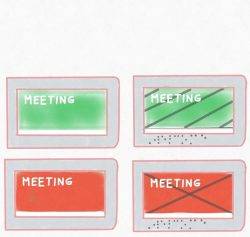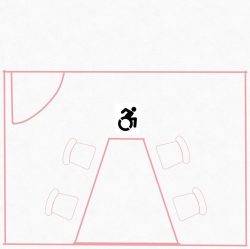June 1, 2018
Opening the door to a new workplace experience for everybody
 There’s no one way to approach diversity and inclusion initiatives. However, we’re very lucky as fellow professionals involved in creating a great workplace experience for everybody to be able to take an active and vital role in improving the setting for these initiatives. If you work at a company that is embracing diversity and inclusion, what I have set out in this commentary is simply a group of thought starters based on previous experience, pain points, and ways you could easily push forward to make spaces that better accommodate all users. At a time when 69 percent of executives rate diversity and inclusion as an important issue, it’s important for we workplace professionals to take the initiative.
There’s no one way to approach diversity and inclusion initiatives. However, we’re very lucky as fellow professionals involved in creating a great workplace experience for everybody to be able to take an active and vital role in improving the setting for these initiatives. If you work at a company that is embracing diversity and inclusion, what I have set out in this commentary is simply a group of thought starters based on previous experience, pain points, and ways you could easily push forward to make spaces that better accommodate all users. At a time when 69 percent of executives rate diversity and inclusion as an important issue, it’s important for we workplace professionals to take the initiative.
Room Schedulers and Wayfinding
 I started my career when we were still using paper schedulers at Google. That feels like a long time ago. Today most companies have a room scheduler on every room of the type with which we are familiar. Unfortunately the way these are typically mounted (usually too high for people in wheelchairs) the way the display is designed (no accommodation for color blind users), and the way the casings work (do not have Braille to accommodate blind users) – is sub par in terms of inclusion.
I started my career when we were still using paper schedulers at Google. That feels like a long time ago. Today most companies have a room scheduler on every room of the type with which we are familiar. Unfortunately the way these are typically mounted (usually too high for people in wheelchairs) the way the display is designed (no accommodation for color blind users), and the way the casings work (do not have Braille to accommodate blind users) – is sub par in terms of inclusion.
How could we change this and easily make it better? A few suggestions are to simply move the scheduler down on the wall, create displays using already known best practices from UX design, and to simply add Braille to the physical sign. Some quick ideas of how this might work are set out in this sketch (right)- but please forgive my terrible skills at drawing:). Again these are just a place to start.
Adding typical UX standards for color – blindness accommodation is easy. It just takes some effort. Also adding Braille at both the higher install level and a lower level helps your meeting rooms more welcoming for blind users. Yes, it’s a legal requirement, but often one people get wrong and don’t update post move in.
Conference Room Seating
As space planners we typically try to maximize the number of seats we can fit into a conference room. This helps our ratios and helps us to make sure that the room feels full. But if a room is tightly designed, and it’s not easy to move chairs around already – what does that mean for a user in a wheelchair? Could you imagine having to come into a meeting, or an interview, and attempt to move a chair out of your way? It doesn’t seem very welcoming at all.
What if we thought about designing conference rooms differently? What if you left a spot at every table for users who might be wheelchair bound. You could easily make sure that this is done by simply leaving one space open, just order one less chair. Adding a simple symbol to the end of the table will help people know that this is a dedicated spot, and also remind your Workplace team know not to place a chair there. A simple example is shown on the right.

Place a symbol at the end of the table to help note that this is a dedicated space. Bonus if it’s the new more inclusive ISO symbol
A Mindset for Inclusion
As I said a few times above, this is just a beginning. These are simply thought starters that are based off my own experience and pain points I’ve observed. So how can you take this further? I’m a big believer in research and that you should do your own to figure out the best way forward for your company. As a starting point I’d suggest the below metrology:
- Research what the legal requirements are in your region. Then question assumptions.
- Are you ahead of them or not even meeting them?
- Are they progressive, or are they falling behind the rest of the world?
- What standard should you use as your base? (Aim higher)
- Consider each area of your space and think about ways in which they could be more inclusive.
- Reception
- Meeting rooms
- Bathrooms
- Signage
- Event spaces!
- Put yourself in their shoes. Use empathy to think about how users with difference physical abilities will utilize your space. Empathy is powerful
- Try it out. Why not create a prototype for your idea and quickly implement it. You might find that it is well received and then have the buy in to keep pushing forward with further initiatives.
There’s no perfect way to start, but starting is the hardest part. Once you begin looking at your workplace with an inclusive mindset, you will be on your way.
Main image: from Deloitte’s 2018 Human Capital Trends report cited in this piece
_______________________________________
 Omar Ramirez is a San Francisco based workplace experience manager and project manager who has worked for firms such as Netflix, Dropbox and Stripe. He now owns his own workplace experience consultancy Affordances as well as working for Atlassian.
Omar Ramirez is a San Francisco based workplace experience manager and project manager who has worked for firms such as Netflix, Dropbox and Stripe. He now owns his own workplace experience consultancy Affordances as well as working for Atlassian.















